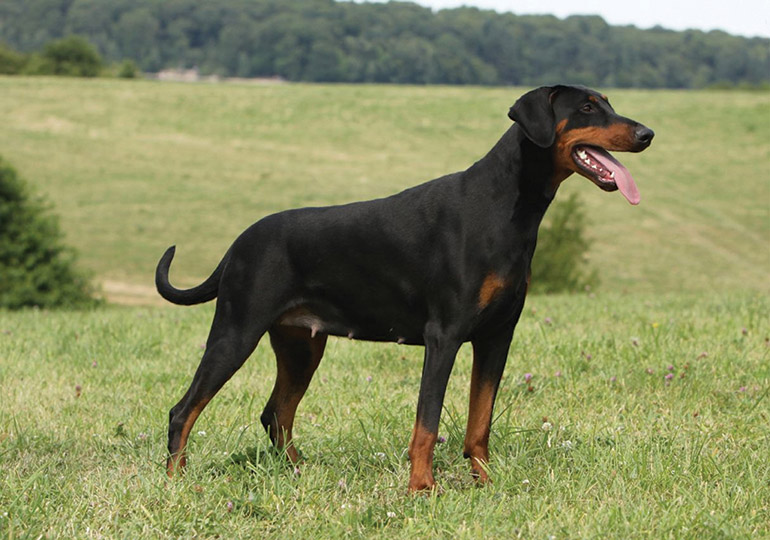
GROUP 6 - UTILITY
The Dobermann is comparatively modern and unusual in that one man is credited with its origin in the 1880s, Louis Dobermann. A nightwatchman and tax collector, he bred for a large terrier-type dog which would be utterly fearless, highly intelligent and a first class personal guard dog.
By the end of the 19th century, Otto Goeller took the rough breed and improved it enormously, retaining its alertness and exceptional qualities as a guard dog, while at the same time softening the breed so that it became a good house dog.
The Dobermann is a muscular, medium-sized strong dog capable of great speed and agility. Elegant with a proud and noble carriage, the Dobermann is energetic determined, fearless, loyal and obedient. Males measure 69cm at the withers and weigh up to 40kg, whereas females are 65cm in height and weigh up to 35kg.
The Dobermann is bred in four colours, with the most common being black with rust red markings, followed by a good proportion of brown and rust markings. The blue and fawn Dobermann rarely occurs in Australia.
Though the breed is physically strong, the Dobermann is not a bully and often lives in harmony with other breeds of dog, as well as cats. There is nothing mean about its character and the Dobermann’s devotion and natural protective instinct make it an ideal companion and trustworthy member of the family.
Intelligent and a quick learner, the breed excels at a variety of activities, including Obedience, Tracking, Agility, rescue and police work, as well as showing capabilities as guide or therapy dogs.
The breed is generally sound and healthy, with a life expectancy of 10-12 years and many living longer. The Dobermann Club of NSW encourages breeder members to test their breeding stock; it is important to purchase your Dobermann from a breeder with a rigorous testing program. Hereditary problems in the breed are Cervical Vertebral Instability (CVI), commonly called ‘Wobblers’, Cardiomyopathy, Hypothyroidism and von Willebrands Disease (vWD). The breed has a small incidence of Hip and Elbow Dysplasia and it can be prone to gastric bloat and cancer.
The Dobermann is easy to care for with its short, smooth coat only requiring the occasional bath and weekly attention to ears, nails and callouses. Regular grooming will keep its coat healthy and shining.
The Dobermann is a highly energetic youngster and quite active adult. It thrives on interaction with its family and does not do well if left in the backyard for long periods of time. Like all dogs, its time spent with children should always be under adult supervision.
An intelligent breed, the Dobermann needs the stimulation of being challenged both mentally and physically to achieve its full potential. Being an active dog, daily walks are highly recommended. As an adult, the breed is often sensible and adaptable, making it an ideal canine companion.
Words: Maria Wheeler on behalf of the Dobermann Club of NSW
Now you know a little about the Dobermann, you may have think that this is the dog for you. Before you make a decision, please make contact with the breed club or your State controlling body for purebred dogs. They will be able to give you information about available puppies and also suggest dog shows where you can see the breed and speak to breeders. In this way you will gain a better perspective of the Dobermann and its needs and whether this breed would suit your lifestyle.


